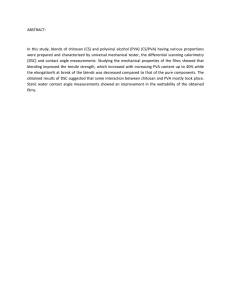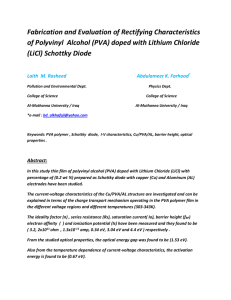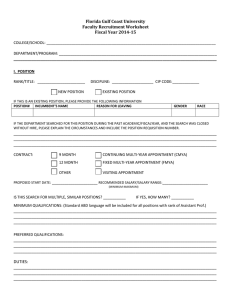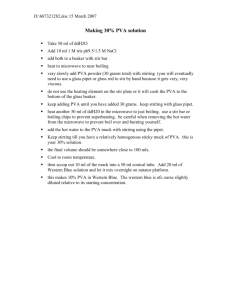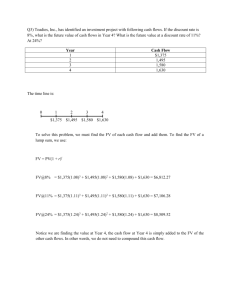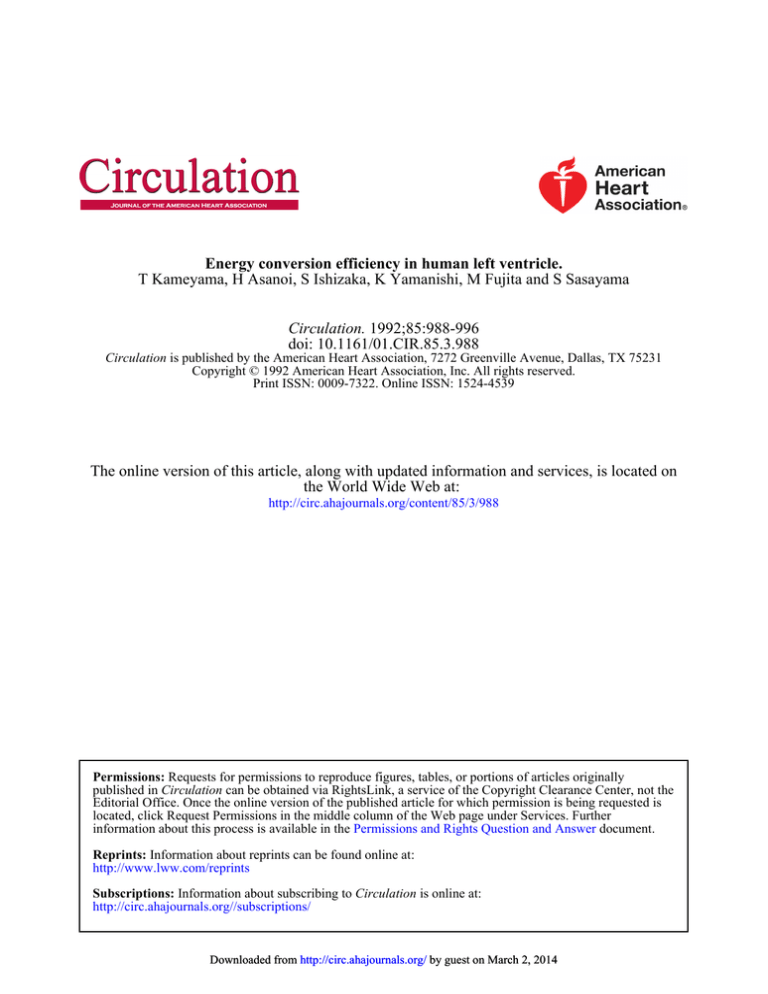
Energy conversion efficiency in human left ventricle.
T Kameyama, H Asanoi, S Ishizaka, K Yamanishi, M Fujita and S Sasayama
Circulation. 1992;85:988-996
doi: 10.1161/01.CIR.85.3.988
Circulation is published by the American Heart Association, 7272 Greenville Avenue, Dallas, TX 75231
Copyright © 1992 American Heart Association, Inc. All rights reserved.
Print ISSN: 0009-7322. Online ISSN: 1524-4539
The online version of this article, along with updated information and services, is located on
the World Wide Web at:
http://circ.ahajournals.org/content/85/3/988
Permissions: Requests for permissions to reproduce figures, tables, or portions of articles originally
published in Circulation can be obtained via RightsLink, a service of the Copyright Clearance Center, not the
Editorial Office. Once the online version of the published article for which permission is being requested is
located, click Request Permissions in the middle column of the Web page under Services. Further
information about this process is available in the Permissions and Rights Question and Answer document.
Reprints: Information about reprints can be found online at:
http://www.lww.com/reprints
Subscriptions: Information about subscribing to Circulation is online at:
http://circ.ahajournals.org//subscriptions/
Downloaded from http://circ.ahajournals.org/ by guest on March 2, 2014
988
Energy Conversion Efficiency in Human
Left Ventricle
Tomoki Kameyama, MD; Hidetsugu Asanoi, MD; Shinji Ishizaka, MD; Kazuto Yamanishi, MD;
Masatoshi Fujita, MD; and Shigetake Sasayama, MD
Background. Left ventricular mechanical efficiency is one of the most important measures of left
ventricular pump performance. Several clinical studies, however, have shown that mechanical efficiency
does not fall substantially as the heart fails. To clarify the insensitivity of mechanical efficiency to the
change in pump performance, we analyzed human left ventricular mechanical efficiency, applying the
concept of left ventricular systolic pressure-volume area (PVA).
Methods and Results. PVA correlates linearly with myocardial oxygen consumption per beat (MVo2):
MVo2=a * PVA+b, and represents the total mechanical energy of contraction. We determined MVo2-PVA
relation and external work in 11 patients with different contractile states. We also calculated the energy
transfer from MVo2 to PVA (PVA/MVo2 efficiency), that from PVA to external work (work efficiency), and
mechanical efficiency (external work/MVo2). Left ventricular pressure-volume loops were constructed by
plotting the instantaneous left ventricular pressure against the left ventricular volume at baseline and
during pressure loading. The contractile properties of the ventricle were defined by the slope of the
end-systolic pressure-volume relation (Ees). Pressure elevation raised external work by 41.4%, PVA by
71.2%, and MVo2 by 54.5%. These changes were associated with a decrease in work efficiency and an
increase in PVA/MVo2 efficiency. The opposite directional changes in these two efficiencies rendered the
mechanical efficiency constant. The slope, a, of the relation between MVo2 and PVA was relatively
constant (2.46±0.33) over the range of 0.8-8.8 mm Hg/ml of Ees, but the oxygen axis intercept, b, tended
to decrease with the reduction in Ees. PVA/MVo2 efficiency correlated inversely (r= -0.66, p <0.05) with
Ees, whereas work efficiency correlated linearly with Ees (r=0.91, p<0.01).
Conclusions. Mechanical efficiency is not appreciably affected by changes in loading and inotropic
conditions as long as the left ventricular contractility is not severely depressed. (Circulation 1992;85:988-996)
KEY WoRDs
pressure-volume relation * oxygen consumption * pressure-volume area
echanical efficiency, one of the most important parameters of the energy transfer system, designates the fraction of total consumed energy that is converted into external work
(EW).12 Previous clinical studies,3-5 however, have documented that if the contractile state of the ventricle is
not severely depressed, left ventricular mechanical efficiency does not change substantially in patients with
cardiac dysfunction. The mechanism for the insensitivity of mechanical efficiency to cardiac function has not
been systematically examined in clinical settings because of the lack of a suitable analytical framework.
Suga6 and Suga et a17 have shown that ventricular
pressure-volume area (PVA) represents the total mechanical energy of contraction (Figure 1), and it correlated linearly with myocardial oxygen consumption per
beat (MVo2). The PVA has a great advantage over the
previous predictors of mechanical energy utilization in
M
From The Second Department of Internal Medicine, Toyama
Medical and Pharmaceutical University, Toyama, Japan.
Presented in part at the 61st Scientific Sessions of the American
Heart Association, Washington, D.C., November 14, 1988.
Address for correspondence: Hidetsugu Asanoi, MD, The Second Department of Internal Medicine, Faculty of Medicine,
Toyama Medical and Pharmaceutical University, 2630 Sugitani,
Toyama 930-01, Japan.
Received July 3, 1990; revision accepted October 22, 1991.
that left ventricular mechanical performance is integrated into the PVA and can be quantitatively related to
MVo2 on the same dimensional basis.8 Therefore, the
PVA concept provides a useful framework to analyze
the relation between the loading and inotropic conditions and mechanical efficiency of the diseased left
ventricle. So far, mechanical energy transfer using the
PVA concept has been examined only under unphysiological states such as excised hearts or anesthetized
animal models.6-9
In the present study, we have extended the analysis of
efficiency of energy transfer6'8 for the first time to
human left ventricles. To clarify the insensitivity of
mechanical efficiency to cardiac deterioration, we have
examined, in patients with normal and moderately
depressed hearts, how the changes in contractile state
and afterload influence the MVo2-PVA relation and
mechanical efficiency.
Methods
Study Patients
The study was performed in 11 patients (mean age, 50
years; range, 36-62 years). Six patients had previous
myocardial infarction, four had cardiomyopathy (two,
idiopathic and two, after myocarditis), and one had
atypical chest pain. Patients who showed clinical symp-
Downloaded from http://circ.ahajournals.org/ by guest on March 2, 2014
Kameyama et al Energy Conversion Efficiency in Human Ventricle
989
External
P-V Loop,
C,)~~~~~~~~~~~~~~~~~~(W
&
Potential
End-diastolic
VolumeArega
EPE
Volume
Volume
FIGURE 1. Schematic ofpressure-volume (P-V) relations of left ventricle (left panel) and P-Varea (PVA) (right panel). Three
P-V loops of ejecting contractions are shown in the left paneL The solid circles at the left upper corners of the loops are the
end-systolic P-Vpoints. The line through these points is the end-systolic P-V line, and its slope is Ees. Diastolic P-V curve consists
of the diastolic segment of these P-V loops. Effective arterial elastance, Ea, is the slope of end-systolic pressure-stroke volume
(P-SV) relation. The origin of the relation line, that is, its volume axis intercept, is a given end-diastolic volume. The stroke volume
is represented on this ventricular volume axis as a distance to the left of this intercept. When the ventricle is coupled with the arterial
system, the equilibrium is determined as the intersection between the arterial end-systolic P-SVline and the ventricular end-systolic
P-V line. PVA is the area in the P-V diagram that is circumscribed by the end-systolic P-V line, the end-diastolic P-V relation
curve, and the systolic segment of P-V trajectory (E-A-B-C-E, right panel). PVA consists of the external work (EW) performed
during systole and the end-systolic elastic potential energy (PE) stored in the ventricular wall at end systole. EW is the area within
the P-V loop trajectory (A-B-C-D-A), and PE is the area between end-systolic P-V line and end-diastolic P-V relation curve to
the left of EW (E-C-D-E).
toms and signs of new myocardial ischemia on treadmill
exercise test or exercise 20`T1 myocardial perfusion scans
were excluded from the study, as were patients with left
ventricular aneurysm or mitral regurgitation. All patients were in normal sinus rhythm, and all medications
were withheld 24 hours before the procedure. The study
protocol was reviewed and approved by the Ethical
Committee of our institute, and informed written consent was obtained from each patient. There were no
complications as a result of the study.
Catheterization Procedure
Cardiac catheterization was performed by the right
brachial approach with the patients in a fasting state.
After conventional diagnostic right and left heart catheterization, coronary arteriography was performed by
the Sones technique. Proximal coronary sinus catheterization was performed with a dual-thermistor thermodilution catheter (Webster Laboratory Inc.).10 A highfidelity micromanometer-tipped catheter (Micro-Tip,
Millar Instruments) was then introduced into the left
ventricle, which allowed simultaneous high-fidelity
pressure measurement during left ventriculography. After sufficient time was allowed after coronary arteriography, coronary sinus blood flow was determined in
duplicate by the standard thermodilution method. The
position of the catheter was checked frequently during
the study by both fluoroscopic appearance and hand
injection of small doses of contrast medium to confirm
the proximal thermistor placed directly into the ostium
of the coronary sinus. Arterial and coronary sinus blood
samples were drawn simultaneously for the determination of oxygen saturation and lactate concentration.
Left ventricular cineangiography was then performed in
the 30° right anterior oblique projection with a Toshiba
9-in. (22.86-cm) image intensification system. Left ventricular opacification was achieved by injecting 35-40
ml of radiopaque nonionic contrast agent (iopamidol)
through a Millar angiographic catheter at a rate of 12
ml/sec. Films were exposed at a rate of 60 frames/sec
with an Arriflex 35 mm cine camera while the patient
was gently holding his breath. During the cineangiographic study, high-fidelity left ventricular pressure,
ECG, cineangiographic frame markers, and an injection
marker were recorded simultaneously.
An adequate recovery time was allowed for the left
ventricular pressure to return to baseline level. Phenylephrine (5 mg/100 ml) was started to increase the
systolic left ventricular pressure by about 50 mm Hg. In
nine patients, the heart rate was kept almost the same as
in the control state by coronary sinus pacing. Measurements of coronary sinus flow and samplings of coronary
sinus blood were taken again under steady-state conditions during pressure elevation. After these measurements, the second cineventriculogram was obtained in
the same manner as in the control state. In seven
patients, myocardial lactate uptake was calculated as
follows: myocardial lactate uptake=(arterial lactatecoronary sinus lactate) x 100/arterial lactate. There
were no signs of pulmonary congestion, appearance of a
transient mitral regurgitation, or other side effects during these procedures.
Generation ofAngiographic
Pressure-Volume Diagrams
The boundary of the ventricular silhouette was delineated manually by Oscon cine analyzer. Left ventricular
Downloaded from http://circ.ahajournals.org/ by guest on March 2, 2014
Circulation Vol 85, No 3 March 1992
990
Ees -3.5 mmHg/ml
150
I
E
100
W
8 50
W
01
00
VOLUME(ml)
W-
a0F
CL
A PYA+B
0.3 5
B = 1.1 j /beat
MVO2=
1
6.0
phenylephrine
N
4.0
control
N
0
2.C
ni!
-0
1.0
2.0
PVA ( j /beat)
FIGURE 2. Graphs show left ventricular pressure-volume
(P-V) diagram for baseline and a high pressure setting with
phenylephrine (upper panel). P-V area (PVA) is the area
circumscribed by the end-systolic P-V line, the end-diastolic
P-V curve, and the systolic segment ofP-Vtrajectory (shaded
area). An end-systolic P-V line was drawn on the left upper
corner of the P-V loops. The left ventricular contractile state
was defined by the slope (Ees) of this relation. Relation
between myocardial oxygen consumption per beat (MVO2)
and PVA in the same patient (case 2) as in the upper panel
(lower panel). MVO2 was plotted as a function of PVA in
basal and high-pressure states. The slope (A) and oxygen axis
intercept (B) of this relation was determined from a straight
line passed through these two points (MVO2=A. PVA +B).
MVO2 and PVA are expressed in joules.
volume (V) was calculated by the area-length method
using a modified Kennedy's formula1': V=0.687xC3x
A2/L+ 1.9, where A is the area of the ventricle calculated from the number of pixels surrounded by the
ventricular boundary, L is the longest measured length
between the midpoint of the aortic valve and the apex,
and C is the linear correction factor for the magnification of a unit of length (one pixel). C was derived from
a comparison with the known area of the filmed 1-cm2
grid placed parallel to the tube at the position of the
heart. The calculated volume of each frame was synchronized to corresponding pressure by simultaneously
recorded exposure marker throughout one cardiac cycle
to obtain the pressure-volume loop.
Ventricular and Arterial End-Systolic
Pressure-Volume Relations
An end-systolic pressure-volume line was drawn on the
left upper corners of the pressure-volume loops of baseline and pressure loading (Figure 2, upper panel). The left
ventricular contractile state was defined by the slope (Ees)
of this end-systolic pressure-volume relation.12,13
Given a constant heart rate, arterial end-systolic pressure changes with stroke volume in a roughly linear
relation. The slope of this relation is in proportion to the
impedance that the arterial tree offers to the stroke flow.
Thus, the arterial properties can be represented as a first
approximation by the arterial end-systolic pressure-stroke
volume relation. Sunagawa et al14 called this slope effective arterial elastance (Ea). We determined Ea as the ratio
of end-systolic pressure to stroke volume both at rest and
during increased afterload.
Left Ventricular Work and Work Efficiency
We measured PVA by planimetry at baseline and
during increased afterload and defined it as the area
within the straight line connecting volume axis intercept
(V0) of the end-systolic pressure-volume line and the
end-systolic point, end-diastolic pressure-volume relation curve, and systolic segment of the pressure-volume
trajectory. PVA in an ejecting contraction consists of
two parts (Figure 1, right panel).6 One is the area within
the pressure-volume loop trajectory (A-B-C-D-A),
which equals left ventricular EW. The other is the area
between the end-systolic and end-diastolic pressurevolume relation curves to the left of EW (E-C-D-E).
This area is considered equal to end-systolic elastic
potential energy built during systole and stored in the
ventricular wall. We analyzed the ratio of EW to PVA,
which represents the efficiency of energy transfer from
the ventricle to the arterial system. This ratio was
termed work efficiency in the present article.15
Mechanical Efficiency and MVo2-PVA Relation
Oxygen contents of arterial and coronary sinus blood
were calculated as the product of the percent oxygen
saturation, oxyhemoglobin binding capacity, and hemoglobin concentration. MVo2 was calculated as the product of coronary sinus blood flow and the arteriocoronary sinus oxygen difference and was expressed on a per
beat basis. Because the energy units of EW and MVo2
are expressed by mm Hg * ml and ml 02, respectively,
these units were converted into a common unit of
energy, joules (J), by use of the following conversions: 1
mmHg*ml=1.33x10-4 J and 1 ml 02=20 J.16 Then
mechanical efficiency was expressed conventionally by
the ratio of EW to MVo2. For each patient, MVo2 was
plotted as a function of PVA in the basal and highpressure states. The slope, a, and oxygen axis intercept,
b, of the relation between MVo2 and PVA were determined from a straight line connecting these two points
(i.e., MVo2=a * PVA+b)6 in the same manner as determined by Burkhoff et al (Figure 2, lower panel).17
Statistical Analysis
Data were expressed as mean±SD. Because the patients served as their own controls, the statistical significance of differences in hemodynamic variables was tested
by paired t test. Values of p<0.05 were considered to
represent a statistical significance. The interrelations between efficiency parameters and basal inotropic state were
quantified by linear regression analysis.
Results
The data for all patients are listed in Table 1. The left
ventricular end-systolic pressure increased by 54.6 +20.9
Downloaded from http://circ.ahajournals.org/ by guest on March 2, 2014
Kameyama et al Energy Conversion Efficiency in Human Ventricle
991
TABLE 1. Left Ventricular and Coronary Hemodynamic Data
DO2
HR
ESP
LVP
EDV ESV
EF
Ea
Ees
CSF
(ml/100
MVo2
LU
Patient (bpm) (mm Hg) (mm Hg) (ml/m2) (mu/m2) (%) (mm Hg/mi) (mm Hg/ml) (ml/min)
ml)
(ml/min)
(%)
156
156
1c
70
22
57
2.72
61
2.21
135
8.9
13.4
38
70
176
176
1P
64
28
2.99
56
10.3
155
16.0
50
120
79
96
2C
66
25
1.50
63
3.54
132
9.4
12.4
40
142
2P
148
60
84
33
1.80
61
162
9.1
14.7
41
100
60
110
64
21
3C
1.08
67
8.80
152
9.7
14.7
7
165
170
24
76
3P
73
67
1.57
190
9.7
18.4
18
100
95
120
4C
61
1.33
2.65
70
18
163
8.9
14.5
42
175
178
4P
80
35
2.22
245
9.8
24.0
95
56
44
124
124
SC
1.88
92
75
34
54
185
12.0
22.3
5.97
35
5P
152
91
152
37
1.95
57
85
240
11.0
26.4
40
63
116
140
6C
76
42
1.93
98
45
8.4
8.2
5.22
48
67
179
180
6P
40
81
49
3.20
11.9
134
8.9
58
75
92
114
7C
20
1.26
70
68
80
12.7
10.2
5.40
57
75
173
176
7P
67
1.88
91
30
130
13.7
17.8
61
8C
65
78
96
153
107
30
11.3
7.9
0.81
0.96
80
nd
128
8P
60
104
125
28
1.17
175
100
11.3
11.3
nd
9C
60
102
113
26
64
59
1.62
3.17
68
10.2
6.9
nd
9P
62
41
179
179
93
130
10.4
13.7
56
2.11
nd
10 C
86
93
99
46
14.2
39
1.90
75
81
11.5
nd
1.43
144
67
148
108
10 P
75
12.0
19.9
38
2.09
165
nd
11 C
79
98
47
73
88
10.5
35
1.84
100
10.5
nd
3.28
11 P
148
88
148
57
87
11.0
34
3.02
150
16.5
nd
Mean C
76
103
117
37
76
10.6
3.86
54
1.64
115
12.1
38
SD
-+-13
+22
+17
±2.31
+26
+26
+1.8
±16
±40
±0.50
±4.3
±+14
Mean P
73
158
162
48
93
164
10.7
51
2.18
17.3
45
+-13
+29
+23
SD
±45
+1.4
+14
±13
+0.64
+4.7
+30
±+17
NS
<0.01
<0.01
<0.01
<0.01 <0.01 <0.05
<0.01
NS
<0.01
<0.01
p
HR (bpm), heart rate (beats per minute); ESP, LVP, left ventricular end-systolic and peak pressures; EDV, ESV, left ventricular
end-diastolic and end-systolic volume; EF, left ventricular ejection fraction; Ea, slope of arterial end-systolic pressure-stroke volume
relation; Ees, slope of left ventricular end-systolic pressure-volume relation; CSF, coronary sinus flow; DO2, arteriocoronary sinus oxygen
difference; MVo2, myocardial oxygen consumption per minute; LU, lactate uptake; C, control; P, phenylephrine; nd, not determined.
-
-
-
-
-
-
Hg with phenylephrine, associated with 35.2±
22.9% increase in Ea. There were significant augmentations of end-diastolic volume and end-systolic volume
and reduction in ejection fraction. Coronary sinus blood
flow increased by 48.1±26.9%, but there were no significant changes in arteriocoronary sinus 02 difference.
Consequently, myocardial oxygen consumption per
minute increased by 49.0±25.9%. Myocardial lactate
uptake also increased in all seven patients, and there
were no signs of myocardial ischemia on the ECG
during these interventions.
Representative pressure-volume loops are shown in
Figure 2. Individual data on the left ventricular work and
energy transfer are listed in Table 2. With pressure
elevation, left ventricular EW increased by 41.4+34.3%,
and end-systolic potential energy was doubled. The PVA
(sum of the area of EW and potential energy) increased by
71.2±33.6%. These changes were accompanied by a decrease in work efficiency (EW/PVA) but an increase in
PVA/MVo2 efficiency. Consequently, mechanical efficiency (EW/MVo2) did not change appreciably.
Ees ranged from 0.81 to 8.8 mm Hg/ml, and left
ventricular ejection fraction ranged from 30% to 70%.
Only four of the patients had depressed ejection fraction (<50%), which did not necessarily correlate with
mm
-
Ees (r=0.48, p>0.10). Figure 3 shows the scatter diacoefficient, a, and oxygen axis intercept, b,
of MVo2-PVA relation against Ees. The reciprocal of
the slope, 1/a, reflects the efficiency with which oxygen
is utilized to generate mechanical energy. This value
was constant, with a mean value of 41% over the wide
range of Ees values. The intercept, b, tended to decline
with depression of contractile state. Figure 4 shows
PVA/MVo2 efficiency and work efficiency plotted as a
function of Ees. The former correlated inversely with
Ees (r=-0.649, p<0.05) and the latter linearly
(r=0.907, p<0.01). Consequently, because of counterbalance of these two efficiencies, mechanical efficiency
(EW/MVo2) remained unchanged (22.1±4.2%) within
the range of Ees or ejection fraction of the patients
studied (Figure 5).
gram of slope
Discussion
The primary determinants of MVo2 are the preload
and afterload and the contractile state of the left
ventricle. PVA is the first and intermediate form of total
mechanical energy, which allows us to relate these
parameters of cardiac mechanical performance to
MVo2 on the same dimensional basis. Tension-time
Downloaded from http://circ.ahajournals.org/ by guest on March 2, 2014
992
Circulation Vol 85, No 3 March 1992
TABLE 2. Left Ventricular Work and Efficiency
PVA
EW
PE
(mm Hg ml)
(mm Hg ml)
(mm Hg ml)
Patient
10,676
4,859
1C
5,817
7,424
1P
5,363
12,787
2C
1,733
3,656
5,389
9,940
2P
4,828
5,112
992
9,781
3C
8,789
12,853
3,159
9,694
3P
8,406
4C
2,882
5,524
4P
9,316
6,490
15,806
7,627
2,117
5C
5,510
10,435
3,435
7,000
5P
6,708
6C
1,717
4,991
9,370
6P
4,658
4,712
7C
6,049
1,631
4,428
13,148
4,474
8,670
7P
7,391
8C
3,216
4,175
11,500
8P
5,504
4,996
7,099
9C
1,937
5,167
14,788
6,715
9P
8,073
7,647
3,299
10 C
4,348
7,554
8,316
10 P
15,870
5,190
11 C
1,441
3,749
10,070
11 P
4,026
6,044
7,452
Mean C
2,348
5,105
SD
+1,697
+1,115
±1,423
12,415
Mean P
5,297
7,027
+2,358
SD
+1,551
+1,863
<0.01
<0.01
<0.01
p
EW/MVo2
(%)
PVA/MVo2
(%)
37
37
23
27
27
28
37
42
21
24
34
35
30
37
40
41
41
45
38
40
29
36
33
EW/PVA
(%)
54
42
68
51
90
75
66
59
72
67
74
50
73
66
56
52
73
55
57
53
72
60
69
20
16
15
14
24
21
25
25
15
16
26
18
22
24
23
21
30
24
22
21
21
21
22
±7
+10
+4
36
+7
<0.01
57
+9
<0.01
20
-+4
NS
a
1/a
(%)
b
(J/beat)
2.64
38
0.08
2.90
35
1.06
3.00
33
1.00
2.08
48
0.68
2.62
38
2.16
2.68
37
0.20
2.16
46
0.97
2.43
41
0.04
2.08
48
0.33
2.40
42
0.22
2.09
48
0.95
2.46
+0.33
41
+6
0.70
+0.63
EW, left ventricular external work; PE, end-systolic potential energy; PVA, pressure-volume area; PVA/MVo2, PVA/myocardial oxygen
consumption efficiency; EW/PVA, work efficiency; EW/MVo2, mechanical efficiency; a, slope of the PVA-MVo2 relation; 1/a, reciprocal of
slope a; b, oxygen axis intercept of PVA-MVo2 relation; J, joule; C, control; P, phenylephrine.
index, peak pressure, and stroke work, which are proposed as clinical predictors of MVo2, can change considerably despite an absence of change in MVo2.18
Myocardial peak force and contractile state have been
viewed as the major predictors of energy consumption.21920 MVo2 for a given peak force increases considerably, however, with shortening and ejection.21 Weber and Janicki21 showed that the time integral of total
systolic force correlated linearly with MVo2 for both
ejecting and isovolumetric contractions in canine left
ventricle. This parameter, however, is not equivalent to
the total mechanical energy generated by ventricular
contraction, as PVA is. Moreover, Suga et al822 have
recently demonstrated that MVo2 remained constant
when the force-time integral was greatly changed by
reciprocally changing afterloaded pressure and enddiastolic volume while keeping PVA constant in a stable
contractile state. The linear muscle version of PVA,
which was called force-length area,23 has also been
shown to correlate closely with MVo2 in ferret papillary
muscles23 and with total heat generated in rabbit papillary muscles.24 All these results support feasibility of
PVA as a linear and close correlate of MVo2.
As far as we know, this is the first study to quantitatively
describe the influence of ventricular contractile state and
afterload on efficiency of energy transfer in human left
ventricle. The present study showed that, with the depres-
sion of contractile state, there arose an increase in energy
conversion from MVo2 to PVA and a decrease in that
from PVA to EW. Mechanical efficiency (EW/MVo2)
remained unchanged over the range of contractile states
of the patients studied. An increase in afterload produced
similar effects on these energy conversion efficiencies. We
used PVA as the total mechanical energy of ejecting
contraction, as defined by Suga.6 According to the PVA
concept,9 mechanical efficiency can be divided into two
steps: the efficiency of energy conversion from MVo2 to
PVA as the first step and the efficiency of energy conversion from PVA to EW as the second step. Then PVA can
be assumed to reflect an intermediate form of energy
between MVO2 and EW.
Energy Conversion Efficiency From MVo2 to PVA
Suga6 and Suga et a125 have demonstrated a linear
relation between MVo2 and PVA with a nonzero positive intercept for PVA=O (MVo2=a* PVA+b, b>O).
The intercept, b, the MVo2 required for a mechanically
unloaded contraction, represents the sum of the basal
energy requirement and the energy required for excitation-contraction coupling.26 They also have shown that
when inotropic state is enhanced, the MVo2-PVA relation shifts upward (increase in b), and when inotropic
state is depressed, the relation shifts downward (de-
Downloaded from http://circ.ahajournals.org/ by guest on March 2, 2014
-~ ~
Kameyama et al Energy Conversion Efficiency in Human Ventricle
50
50
0
401_
eh
0
8
. 0
a
* S
0
0
0
8
cc-
a
- 0
40
-
0~
20~
NS
Y =-2.0 x+40.2
r =-0.66
P <0.05
00~~~
0
0~~~~~~~~~~~~~4
0~~~~~~~
0
30
(M
N
301_
993
2010
r =0.59
P<O.
a,
.0
80[
0
4-
2.0.
0-
en
.
90
o0
CD
.
A
,
,a1
*
o
1.0
0
1.0
N'
~
0
0
co~
0
^.^..
2.0
3:
40
.SO
0
.
.
80
O
V
L
0
0
70
t.
0. 0
Ees (mmHg/mI )
FIGURE 3. Scatterplots show the relation between the basal
inotropic state (Ees) and the slope coefficient (A) and oxygen
axis intercept (B) of myocardial oxygen consumption-pressure
volume area relation. The reciprocal of the slope (1/A) reflects
the efficiency with which oxygen is utilized to generate mechanical energy. This efficiency was constant with a mean
value of 41% over a wide range of Ees (upper panel).
Intercept B, non-work-related oxygen consumption, tended to
decline with the depression of contractile state (lower panel).
crease in b), without significant change in the slope, a, of
the relation. The reciprocal of the slope of the linear
MVo2-PVA relation has been considered to represent
the efficiency of chemomechanical transduction of the
contractile machinery of the left ventricle. In excised
dog hearts, this efficiency ranged from 30% to 50%
regardless of the loading, heart rate, and inotropic
conditions.25-27 The present study demonstrated that
this efficiency averaged 41% in human left ventricle at
any level of contractile state. Under these circumstances, PVA/MVo2 efficiency increases with the depression of contractile state for a given PVA and with an
increase in PVA accompanied by an increase in afterload (Figure 6, left panel).
Left Ventricular Work Efficiency
Work efficiency, EW/PVA, represents the efficiency of
mechanical energy transfer from the ventricle to the
arterial system.9 This efficiency decreased with the depression of the contractile state or with an increase in afterload. If we assume that the time-averaged ventricular
pressure during ejection is close to end-systolic pressure
and left ventricular diastolic pressure is negligible compared with the pressure during ejection, EW can be
approximated by the product of stroke volume and end-
Y = 4.0
60~
WI
0
50
x
+53.1
r = 0.91
P<0.01
F
40
.
0
2
4
6
8
10
Ees (mmHg/mI)
FIGURE 4. Graphs show relation between PVAIMVO2 efficiency and work efficiency (EWIPVA) and the basal inotropic
state (Ees). PVA/MVO2 correlated inversely with Ees, and
work efficiency decreased linearly with the reduction in Ees.
PVA, pressure-volume area; MVO2, myocardial oxygen consumption per beat; EW, left ventricular external work; Ees,
slope of end-systolic pressure-volume relation.
systolic pressure. Work efficiency
can
be formulated28
as
EW/PVA=1/[1+(Ea/Ees)/2], where Ea represents the
arterial input impedance properties (effective arterial
elastance) expressed by the slope of arterial end-systolic
pressure-stroke volume relation. This formula implies
that work efficiency is a function of basal inotropic state
(Ees) and afterload (Ea). In a previous study,15 we have
demonstrated that in patients with variably depressed
hearts, work efficiency was actually related to the Ea/Ees
ratio. This relation is shown schematically in Figure 6
(right panel), which illustrates two different inotropic
conditions and two different effective arterial elastances.
This conceptual framework shows that a depression of
contractile state or an increase in afterload increases the
Ea/Ees ratio and end-systolic potential energy and reduces work efficiency.
Left Ventricular Mechanical Efficiency
According to earlier studies,1-4,29,30 cardiac mechanical efficiency varies between 0 and 45%, with normal
functioning values of 10% to 25%. Our present data fell
within this range. The mechanical efficiency is affected
by ventricular preload, afterload, and contractile state.
The influence of these factors on efficiency, however,
has been difficult to analyze in quantitative terms. Evans
Downloaded from http://circ.ahajournals.org/ by guest on March 2, 2014
Circulation Vol 85, No 3 March 1992
994
40
30
0
2
0
2020 **
*
3:
10
0
2.0
4.0
G.0
Ees (mmHg/mi)
40
30
_^il
20
0o
2
20
*
~
-1
10
o
20
40
60
loading during cineventriculography. According to Baxley et a13 or Nichols et al,4 most of the patients with
ejection fraction less than 40% showed a significant
reduction in mechanical efficiency. In patients with
** *
ejection fraction greater than 40%, however, mechanical efficiency did not always decrease to that extent. In
the present study, mechanical efficiency did not correlate with left ventricular ejection fraction. The mechanism for relatively constant mechanical efficiency in
moderately depressed hearts can be explained by the
o . . . . .PVA concept (Figure 6). In these hearts, the reduction
8.0
10.0
in non-work-related oxygen consumption, b, raises
PVA/MVo2 efficiency, which counteracts the reduction
in work efficiency so as to maintain mechanical efficiency. When the heart is severely depressed, however,
the substantial fall in work efficiency would predominate over the increase in PVA/MVo2 efficiency, resulting in a mismatch in terms of mechanical efficiency.
Similar mechanisms could also work in the response of
mechanical efficiency to pressure loading.
0
3
* 3The present study included six patients with previous
myocardial infarction. In these patients, MVo2 might be
augmented in maintaining increased regional systolic
wall stress, which could not be expressed within the
pressure-volume diagram. Therefore, if wall stress were
used instead of pressure, different findings might occur
in patients with regional wall motion abnormalities.
80
EF (%)
FIGURE 5. Scatterplots show relation between the mechanical efficiency (EW/MVO2) and the basal inotropic state (Ees)
(upper panel) or ejection fraction (EF) (lower panel).
Mechanical efficiency remained unchanged (mean 22.1%)
against different Ees or EF levels. EW, left ventricular
external work; MVo2, myocardial oxygen consumption per
beat; Ees, slope of end-systolic pressure-volume relation.
and Matsuokal first observed in Starling heart-lung
preparations that mechanical efficiency decreased as
the condition of the heart preparations deteriorated.
They also found that cardiac efficiency was greater
during volume loading than during pressure loading.
Bing et a129 measured left ventricular efficiency in
humans. Mean efficiency value for normal subjects was
22%, which compared remarkably well with the average
value of 15% for patients with congestive heart failure.
Baxley et al3 calculated mechanical efficiency in patients
with variably depressed hearts resulting from valvular or
myocardial disease. The range of efficiency varied from
4% to 40%, with the smallest value formed in patients
with primary myocardial disease. They showed that
mechanical efficiency was roughly correlated with ejection fraction. Recently, Nichols et a14 showed a similar
relation between ejection phase indexes and left ventricular mechanical efficiency in patients with coronary
artery disease.
The present study demonstrated that mechanical
efficiency was comparable in patients with mildly to
moderately depressed hearts. We consider that the
differences between our results and those in earlier
studies probably result from severity of cardiac depression, because we exclude patients with severe cardiac
dysfunction, who may have a risk in pressure or volume
Limitations
Several methodological problems must be discussed.
Because volume data are limited by left ventriculography,
we derived the relation between PVA and MVo2 only for
two pressure settings in each subject, one baseline pressure and another relatively high pressure. For this analysis,
we took advantage of the fact that despite the great
difference in heart size, a high correlation of the linear
MVo2-PVA relation has been shown both in dog hearts
and in rabbit hearts.31 Minor fluctuation of contractility
caused by baroreflex-mediated alterations in sympathetic
discharge cannot be excluded. In this regard, Suga et a132
reported that the changes in the slope of end-systolic
pressure-volume line caused by either carotid sinus or
aortic baroreceptor reflexes were only about 13% when
arterial pressure was changed between 100 mm Hg and
150 mm Hg. In addition, Vatner et a133 found that in
conscious animals, the baroreflex control of cardiac contractility was even weaker than in the anesthetized state.
Therefore, the reflex change in the slope of end-systolic
pressure-volume relation in our study could be negligible.
Pressure loading potentially causes a transient mitral
regurgitation, which might modify the increase in
MVo234 and the change in mechanical efficiency because
mitral regurgitation increases left ventricular flow work
but decreases potential energy. The present study,
however, confirmed that there were no signs of mitral
regurgitation either at rest or during pressure elevation.
The thermodilution technique for estimation of coronary blood flow has been used in the past several years.
The accuracy of this method greatly depends on the
catheter position within the coronary sinus, and only
large changes (more than 30%) in coronary blood flow
are likely to be qualitatively accurate.35 We paid meticulous attention throughout these studies to proximal
positioning of the external thermistor. The change in
Downloaded from http://circ.ahajournals.org/ by guest on March 2, 2014
Kameyama et al Energy Conversion Efficiency in Human Ventricle
995
8.0
C
m
CO
EE
W
a
4.0
or
cm
0
0.
0
1.0
2.0
200
100
VOLUME (
PVA ( joule/beat )
ml
)
FIGURE 6. Schematic of MVO2-PVA relation line and isoefficiency line (left panel). Family of isoefficiency lines (dashed lines)
indicates various efficiencies of energy conversion from MVO2 to PVA. The depression of contractile state shifts MVO2-PVA
relation (solid line) downward in parallel and increases PVAIMVO2 efficiency for a given PVA. Given a constant inotropic state,
PVA/MVO2 efficiency increases with an increase in PVA. Effects of contractility and afterload on work efficiency of the left
ventricle (right panel). Solid pressure-volume loops indicate baseline and a high-pressure state in normal heart. Dashed loops also
represent basal and a high-pressure state in depressed heart. A depression of contractile state results in a substantial increase in
end-systolic potential energy and reduces work efficiency. For a given rise in afterload, the reduction in work efficiency is more
marked in the depressed heart than in the normal heart. MVO2, myocardial oxygen consumption per beat; PVA, pressure-volume
area; Ees, slope of end-systolic pressure-volume relation; Ea, slope of end-systolic pressure-stroke volume relation.
coronary blood flow in this study was 42.2%. With each
patient serving as his own control and with little change
in heart rate, data thus collected should reliably reflect
changes in coronary sinus flow.
Recent evidence indicates that the ionic contrast
medium can significantly alter myocardial metabolism
by increasing the free fatty acid uptake of the myocardium while decreasing the myocardial uptake of glucose
and lactate.36 In the present study, we carried out left
ventriculography using nonionic contrast agents, which
exhibit considerably less myocardial toxicity. Sufficient
time was also allowed between two left ventriculographies. Therefore, the effects of contrast medium on
cardiac performance and metabolism would be minimized in this study.
Finally, because of the small numbers and heterogeneity of the patients, the data obtained were somewhat
scattered and could contain modest quantitative error.
However, hemodynamic changes seen in our study were
dramatic and relatively uniform during pressure manipulation. Therefore, quantitative factors probably would
little affect the present results.
In summary, we applied the PVA concept to evaluate
energy conversion efficiency in human left ventricles.
Our results showed that mechanical efficiency does not
change appreciably with depression of contractile state
or an increase in afterload as long as the left ventricular
pump function is not severely compromised. The decreased sensitivity of mechanical efficiency can be accounted for by the counteraction of PVA/MVo2 efficiency and work efficiency. Thus, the concept of PVAmediated energy transfer would provide us a rational
basis to gain insight into the energetic aspects of human
left ventricle under normal and pathological conditions.
Acknowledgment
We thank Professor H. Suga, Okayama University, for his
valuable suggestions.
References
1. Evans CL, Matsuoka Y: The effect of various mechanical conditions on the gaseous metabolism and efficiency of the mammalian
heart. J Physiol (Lond) 1915;49:378-405
2. Gibbs CL: Cardiac energetics. Physiol Rev 1978;58:174-254
3. Baxley WA, Dodge HT, Rackley CE, Sandler H, Pugh D: Left
ventricular mechanical efficiency in man with heart disease. Circulation 1977;55:564-568
4. Nichols AB, Pearson MH, Sciacca RR, Cannon PJ: Left ventricular mechanical efficiency in coronary artery disease. J Am Coll
Cardiol 1986;7:270-279
5. Hasenfuss G, Holubarsch C, Heiss HW, Meinertz T, Bonzel T,
Wais U, Lehmann M, Just H: Myocardial energetics in patients
with dilated cardiomyopathy: Influence of nitroprusside and enox-
imone. Circulation 1989;80:51-64
6. Suga H: Total mechanical energy of a ventricle model and cardiac
oxygen consumption. Am J Physiol 1979;236(Heart Circ Physiol
5):H498-H505
7. Suga H, Hayashi T, Shirahata M, Suehiro S, Hisano R: Regression of
cardiac oxygen consumption on ventricular pressure-volume area in
dog. Am J Physiol 1981;240(Heart Circ Physiol 9):H320-H325
8. Suga H, Goto Y, Nozawa T, Yasumura Y, Futaki S, Tanaka N:
Force-time integral decreases with ejection despite constant oxygen consumption and pressure-volume area in dog left ventricle.
Circ Res 1987;60:797-803
9. Nozawa T, Yasumura Y, Futaki S, Tanaka N, Uenishi M, Suga H:
Efficiency of energy transfer from pressure-volume area to external mechanical work increases with contractile state and decreases
with afterload in the left ventricle of the anesthetized closed chest
dog. Circulation 1988;77:1116-1124
10. Ganz W, Tamura K, Marcus HS, Donoso R, Yoshida S, Swan
HJC: Measurement of coronary sinus blood flow by continuous
thermodilution in man. Circulation 1971;44:181-195
11. Kennedy JW, Trenholme SE, Kasser IS: Left ventricular volume
and mass from single plane angiogram: A comparison of anteroposterior and right anterior oblique methods. Am Heart J 1970;80:
343-352
12. Suga H, Sagawa K, Shoukas AA: Load independence of the
instantaneous pressure-volume ratio of the canine left ventricle
and effects of epinephrine and heart rate on the ratio. Circ Res
1973;32:314-322
13. Suga H, Sagawa K: Instantaneous pressure-volume relationships
and their ratio in the excised, supported canine left ventricle. Circ
Res 1974;35:117-126
Downloaded from http://circ.ahajournals.org/ by guest on March 2, 2014
996
Circulation Vol 85, No 3 March 1992
14. Sunagawa K, Maughan WL, Burkhoff D, Sagawa K: Left ventricular interaction with arterial load studied in isolated canine heart.
Am J Physiol 1983;245(Heart Circ Physiol 14):H773-H780
15. Asanoi H, Sasayama S, Kameyama T: Ventriculoarterial coupling
in normal and failing heart in humans. Circ Res 1989;65:483-493
16. Coulson RL: Energetics of isovolumic contractions of the isolated
rabbit heart. J Physiol (Lond) 1976;260:43-53
17. Burkhoff D, Yue DT, Oikawa RY, Franz MR, Schaefer J, Sagawa
K: Influence of ventricular contractility on non-work related
myocardial oxygen consumption. Heart Vessels 1987;3:66-72
18. Suga H, Hayashi T, Suehiro S, Hisano R, Shirahata M: Equal
oxygen consumption rates of isovolumic and ejecting contractions
with equal systolic pressure volume areas in canine left ventricle.
Circ Res 1981;49:1082-1091
19. McDonald RH: Developed tension: A major determinant of
myocardial oxygen consumption. Am J Physiol 1966;210:351-356
20. Henry PD, Eckberg D, Gault JH, Ross J: Depressed inotropic
state and reduced myocardial oxygen consumption in the human
heart. Am J Cardiol 1973;31:300-306
21. Weber KT, Janicki JS: Myocardial oxygen consumption: The role
of wall force and shortening. Am J Physiol 1977;233(Heart Circ
Physiol 2):H421-H430
22. Suga H, Nozawa T, Yasumura Y, Futaki S, Ohgoshi Y, Yaku H,
Goto Y: Force-time integral does not improve predictability of
cardiac 02 consumption from pressure-volume area (PVA) in dog
left ventricle. Heart Vessels 1990;5:152-158
23. Hisano R, Cooper G: Correlation of force-length area with oxygen
consumption in ferret papillary muscle. Circ Res 1987;61:318-328
24. Gibbs CL, Chapman JB: Cardiac energetics, in Ter Keurus HEDJ,
Tyberg JV (eds): Mechanics of the Circulation. Dordrecht/Boston/
Lancaster, Martinus Nijhoff Publishing, 1987, pp 69-86
25. Suga H, Hayashi T, Shirahata M: Ventricular systolic pressure
volume area as predictor of cardiac oxygen consumption. Am J
Physiol 1981;240(Heart Circ Physiol 9):H39-H44
26. Suga H, Hisano R, Goto Y, Yamada 0, Igarashi Y: Effects of
positive inotropic agents on the relation between oxygen consump-
27.
28.
29.
30.
tion and systolic pressure volume area in canine left ventricle. Circ
Res 1983;53:306-318
Suga H, Hisano R, Hirata S, Hayashi T, Yamada 0, Ninomiya I:
Heart rate-independent energetics and systolic pressure-volume
area in dog heart. Am J Physiol 1983;244(Heart Circ Physiol
13):H206-H214
Burkhoff D, Sagawa K: Ventricular efficiency predicted by an
analytical model. Am J Physiol 1986;250(Regulatory Integrative
Comp Physiol 19):R1021-R1027
Bing RJ, Hammond MM, Handelsman JC, Powers SR, Spencer
FC, Eckenhoff JE, Goodale WT, Hafkenschiel JH, Kety SS: The
measurement of coronary blood flow, oxygen consumption and
efficiency of the left ventricle in man. Am Heart J 1949;38:1-24
Bing RJ, Michal G: Myocardial efficiency. Ann N Y Acad Sci
1959;72:555-558
31. Goto Y, Slinker B, LeWinter M: Similar normalized Emax and O2
consumption-pressure-volume area relation in rabbit and dog. Am
J Physiol 1988;255(Heart Circ Physiol 24):H366-H374
32. Suga H, Goto Y, Yasumura Y, Nozawa T, Futaki S, Tanaka N,
Uenishi M: 02 consumption of dog heart under decreased coronary perfusion and propranolol. Am J Physiol 1988;254(Heart Circ
Physiol 23):H292-H303
33. Vatner SF, Higgins CB, Franklin D, Braunwald E: Extent of
carotid sinus regulation of the myocardial contractile state in
conscious dogs. J Clin Invest 1972;51:995-1008
34. Urschel CW, Covell JW, Graham TP, Clancy RL, Ross J, Sonnenblick EH, Braunwald E: Effects of acute valvular regurgitation on
the oxygen consumption of the canine heart. Circ Res 1968;23:
33-43
35. Marcus ML, Wilson RF, White CW: Methods of measurement of
myocardial blood flow in patients: Critical review. Circulation
1987;76:245-253
36. Wisneski JA, Gertz EW, Neese RA, Morris DL: Absence of
myocardial biochemical toxicity with non ionic contrast agent
(iopamidol). Am Heart J 1985;110:609-617
Downloaded from http://circ.ahajournals.org/ by guest on March 2, 2014

